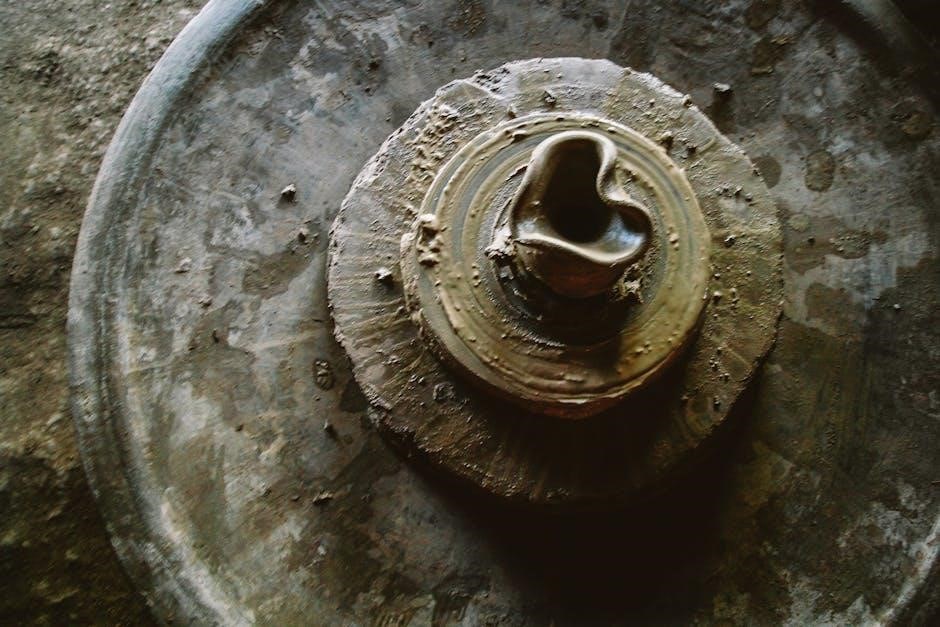The interplay of treaties‚ trench warfare‚ and the grim reality of mud and blood shaped World War I’s trajectory‚ leaving a lasting impact on global history and humanity.
The Outbreak of World War I and Its Global Impact
World War I erupted in 1914‚ triggered by the assassination of Archduke Franz Ferdinand‚ amplifying a complex web of alliances and tensions across Europe. The conflict quickly escalated into a global war‚ drawing in nations from multiple continents. The rigid system of treaties and alliances created an environment where a localized dispute spiraled into widespread devastation. Millions of soldiers and civilians perished as the war introduced unprecedented levels of destruction‚ including the use of trench warfare and advanced weaponry. The global economy was severely disrupted‚ leading to widespread hardship and social unrest. The war’s aftermath reshaped international borders‚ contributed to the rise of new political ideologies‚ and left a lasting scar on humanity‚ marking it as one of history’s most catastrophic events.
The Role of Treaties in Shaping the Conflict

The complex system of alliances and treaties before World War I created a volatile political landscape. Agreements like the Triple Entente and Triple Alliance drew nations into a web of obligations‚ turning a regional dispute into a global conflict. These treaties‚ designed to maintain balance‚ instead fostered rigid alliances that left little room for neutrality or diplomacy. The inflexible nature of these agreements escalated tensions‚ as countries felt compelled to honor their commitments‚ even when it led to war. This diplomatic framework played a crucial role in the outbreak and expansion of the conflict‚ ultimately shaping the war’s conduct and its devastating consequences.

The Trenches of World War I
The trenches were extensive networks of ditches dug by soldiers‚ serving as protective barriers from enemy fire. These muddy‚ blood-soaked trenches became synonymous with the brutal reality of modern warfare.

Life in the Trenches: Conditions and Challenges
Life in the trenches during World War I was brutal and dehumanizing. Soldiers endured a harsh environment filled with mud‚ blood‚ and decay. The trenches were often overcrowded‚ poorly ventilated‚ and prone to flooding‚ making conditions unsanitary and miserable. Men were exposed to the elements‚ with freezing winters and sweltering summers. Disease spread rapidly due to the presence of rotting bodies‚ rats‚ and lice. Soldiers faced constant threats from enemy fire‚ artillery bombardments‚ and the ever-present risk of trench collapses. Psychological strain was immense‚ with the relentless sounds of gunfire‚ screams‚ and the stench of death weighing heavily on their minds; The trenches became a symbol of the war’s futility‚ where survival was a daily struggle.
The Psychological and Physical Toll on Soldiers
The psychological and physical toll on soldiers during World War I was immense. Prolonged exposure to the harsh conditions of trench warfare led to widespread mental health issues‚ including shell shock‚ anxiety‚ and depression. Soldiers faced constant fear of death‚ witnessing the mutilation and loss of comrades‚ which deeply traumatized many. Physically‚ they endured malnutrition‚ diseases like trench foot‚ and the relentless strain of living in damp‚ unsanitary environments. The stench of decay‚ the presence of rats‚ and the constant sounds of gunfire exacerbated their suffering. Many soldiers returned home with lasting psychological scars‚ unable to escape the haunting memories of the trenches. The war left an indelible mark on their lives‚ reshaping their perception of humanity and conflict forever.
The Mud and Blood of Trench Warfare
Trench warfare was marked by relentless mud‚ bloodshed‚ and unsanitary conditions. Soldiers endured wet‚ filthy environments‚ disease‚ and the stench of decay‚ while constant artillery fire magnified the horror.
The Environmental and Human Cost of Trenches
The trenches of World War I created devastating environmental and human tolls. Landscapes were scarred by extensive digging‚ leading to deforestation and soil degradation. The constant presence of mud‚ decay‚ and rot created unhygienic conditions‚ fostering diseases like trench fever and dysentery. Soldiers endured relentless exposure to dampness‚ which caused trench foot and other health issues. The psychological impact was equally profound‚ as the stench of death‚ rats‚ and decay lingered in the air. The trenches became a symbol of suffering‚ where the natural environment was transformed into a lethal battlefield. The human cost was immeasurable‚ with millions enduring physical and mental scars that lasted a lifetime.
Technological Advancements and Their Impact on Warfare
World War I witnessed significant technological advancements that transformed warfare‚ making it more industrialized and deadly. The introduction of tanks revolutionized land warfare‚ providing mobility and protection against machine guns. Artillery became more precise and destructive‚ with howitzer guns capable of launching massive shells over long distances. The use of poison gas‚ such as mustard gas‚ introduced a new era of chemical warfare‚ causing indiscriminate suffering. Airpower emerged as a key component‚ with aircraft and zeppelins used for reconnaissance and bombing. These innovations led to unprecedented casualties and prolonged the conflict. The war also spurred developments in trench engineering‚ with reinforced bunkers and underground tunnels becoming common. These advancements not only changed the nature of warfare but also left a lasting impact on military strategy and technology. The psychological toll on soldiers was immense‚ as they faced unprecedented forms of destruction. The integration of technology into warfare set a precedent for future conflicts‚ emphasizing the importance of innovation in achieving military dominance. The environmental and human costs of these advancements were staggering‚ reshaping battlefields and societies alike. The legacy of World War I’s technological innovations continues to influence modern warfare‚ highlighting the dual nature of progress and devastation. The war’s technological advancements remain a critical area of study‚ offering lessons on the ethical and practical implications of military innovation. The interplay of technology and warfare during this period underscored the brutal efficiency of modern conflict‚ leaving an indelible mark on history. The development of new weapons and tactics during World War I laid the foundation for the sophisticated weaponry of the 20th century‚ forever altering the landscape of global conflict. The use of technology in warfare also highlighted the importance of adaptability and strategic thinking on the battlefield. As nations continue to evolve their military capabilities‚ the lessons of World War I serve as a reminder of the profound impact of technological advancements on human conflict. The integration of technology into warfare during this period demonstrated the devastating consequences of unchecked innovation‚ urging caution in the development and deployment of advanced weaponry. The technological advancements of World War I not only shaped the outcome of the conflict but also set the stage for the development of even more lethal technologies in the decades that followed. The war’s emphasis on technological superiority underscored the growing importance of science and engineering in modern warfare‚ creating a new era of military-industrial complexity. The lasting impact of these advancements is evident in the continued evolution of weaponry and tactics‚ as nations strive to maintain a technological edge on the battlefield. The interplay of technology and warfare during World War I remains a pivotal moment in history‚ offering valuable insights into the dynamics of modern conflict. The development and deployment of new technologies during the war highlighted the delicate balance between innovation and ethics‚ a theme that continues to resonate in contemporary discussions on warfare. As the world moves forward‚ the lessons of World War I’s technological advancements serve as a reminder of the importance of responsibly harnessing innovation to prevent future devastation. The integration of technology into warfare during this period also underscored the growing interconnectedness of global conflicts‚ as nations sought to leverage advancements to gain strategic advantages. The technological legacy of World War I continues to influence military doctrine‚ emphasizing the need for adaptability and innovation in an ever-changing geopolitical landscape. The use of technology in warfare during this period demonstrated the profound impact of scientific progress on human conflict‚ reshaping the way wars are fought and won. The advancements made during World War I set a precedent for the rapid development of weaponry in the 20th century‚ leading to the sophisticated technologies seen in modern warfare. The interplay of technology and warfare during this period also highlighted the importance of international cooperation in regulating the development and use of advanced weaponry. The lessons of World War I’s technological advancements continue to inform contemporary debates on military ethics and the responsible use of technology in conflict. The development of new technologies during the war underscored the growing complexity of modern warfare‚ as nations sought to integrate scientific advancements into their military strategies. The technological innovations of World War I not only changed the face of warfare but also left a lasting impact on the global political landscape‚ shaping the course of history for decades to come. The integration of technology into warfare during this period demonstrated the profound influence of scientific progress on human conflict‚ offering valuable insights into the dynamics of modern warfare. The advancements made during World War I set a precedent for the rapid development of weaponry in the 20th century‚ leading to the sophisticated technologies seen in modern warfare. The interplay of technology and warfare during this period also highlighted the importance of international cooperation in regulating the development and use of advanced weaponry. The lessons of World War I’s technological advancements continue to inform contemporary debates on military ethics and the responsible use of technology in conflict. The development of new technologies during the war underscored the growing complexity of modern warfare‚ as nations sought to integrate scientific advancements into their military strategies. The technological innovations of World War I not only changed the face of warfare but also left a lasting impact on the global political landscape‚ shaping the course of history for decades to come. The integration of technology into warfare during this period demonstrated the profound influence of scientific progress on human conflict‚ offering valuable insights into the dynamics of modern warfare. The advancements made during World War I set a precedent for the rapid development of weaponry in the 20th century‚ leading to the sophisticated technologies seen in modern warfare. The interplay of technology and warfare during this period also highlighted the importance of international cooperation in regulating the development and use of advanced weaponry. The lessons of World War I’s technological advancements continue to inform contemporary debates on military ethics and the responsible use of technology in conflict. The development of new technologies during the war underscored the growing complexity of modern warfare‚ as nations sought to integrate scientific advancements into their military strategies. The technological innovations of World War I not only changed the face of warfare but also left a lasting impact on the global political landscape‚ shaping the course of history for decades to come. The integration of technology into warfare during this period demonstrated the profound influence of scientific progress on human conflict‚ offering valuable insights into the dynamics of modern warfare. The advancements made during World War I set a precedent for the rapid development of weaponry in the 20th century‚ leading to the sophisticated technologies seen in modern warfare. The interplay of technology and warfare during this period also highlighted the importance of international cooperation in regulating the development and use of advanced weaponry. The lessons of World War I’s technological advancements continue to inform contemporary debates on military ethics and the responsible use of technology in conflict. The development of new technologies during the war underscored the growing complexity of modern warfare‚ as nations sought to integrate scientific advancements into their military strategies. The technological innovations of World War I not only changed the face of warfare but also left a lasting impact on the global political landscape‚ shaping the course of history for decades to come. The integration of technology into warfare during this period demonstrated the profound influence of scientific progress on human conflict‚ offering valuable insights into the dynamics of modern warfare. The advancements made during World War I set a precedent for the rapid development of weaponry in the 20th century‚ leading to the sophisticated technologies seen in modern warfare. The interplay of technology and warfare during this period also highlighted the importance of international cooperation in regulating the development and use of advanced weaponry. The lessons of World War I’s technological advancements continue to inform contemporary debates on military ethics and the responsible use of technology in conflict. The development of new technologies during the war underscored the growing complexity of modern warfare‚ as nations sought to integrate scientific advancements into their military strategies. The technological innovations of World War I not only changed the face of warfare but also left a lasting impact on the global political landscape‚ shaping the course of history for decades to come. The integration of technology into warfare during this period demonstrated the profound influence of scientific progress on human conflict‚ offering valuable insights into the dynamics of modern warfare. The advancements made during World War I set a precedent for the rapid development of weaponry in the 20th century‚ leading to the sophisticated technologies seen in modern warfare. The interplay of technology and warfare during this period also highlighted the importance of international cooperation in regulating the development and use of advanced weaponry. The lessons of World War I’s technological advancements continue to inform contemporary debates on military ethics and the responsible use of technology in conflict. The development of new technologies during the war underscored the growing complexity of modern warfare‚ as nations sought to integrate scientific advancements into their military
The Treaties That Shaped the Post-War World
The Treaty of Versailles and other post-war agreements redrew global borders‚ imposed harsh penalties‚ and sought to establish a new international order‚ influencing decades of geopolitics.
The Treaty of Versailles and Its Consequences
The Treaty of Versailles‚ signed in 1919‚ officially ended World War I and imposed severe penalties on Germany. The treaty’s War Guilt Clause blamed Germany for the war‚ leading to heavy reparations and territorial losses. These measures fueled economic hardship and national resentment‚ contributing to the rise of Adolf Hitler and the Nazi Party. The treaty also redrew Europe’s borders‚ creating unstable nation-states and ethnic tensions. While it aimed to establish a lasting peace‚ the treaty’s punitive nature instead sowed the seeds of World War II. Its legacy remains a critical example of how post-conflict agreements can shape global stability and conflict. The treaty’s impact on Germany and Europe was profound and far-reaching.
Other Key Treaties and Their Role in Rebuilding Europe
Beyond the Treaty of Versailles‚ other key treaties played pivotal roles in reshaping post-war Europe. The Treaty of Saint-Germain-en-Laye (1919) dissolved the Austro-Hungarian Empire‚ while the Treaty of Trianon (1920) drastically reduced Hungary’s territory. These agreements aimed to create new nation-states based on self-determination but often led to ethnic tensions and territorial disputes. The Treaty of Sèvres (1920) targeted the Ottoman Empire‚ redrawing Middle Eastern borders‚ though it was later revised. These treaties sought to establish stability but often sowed seeds of future conflict. Their economic and political repercussions‚ including reparations and border adjustments‚ left lasting scars on Europe‚ influencing the rise of fascism and interwar instability. These treaties remain crucial in understanding the complex legacy of World War I.
Remembering the Sacrifices and Struggles of the War
World War I left a profound legacy‚ highlighting the devastating impact of treaties‚ trench warfare‚ and human sacrifice. Its lessons remain vital for global peace and diplomacy.